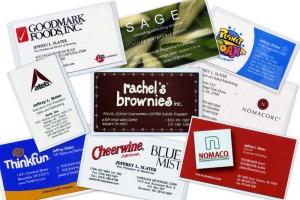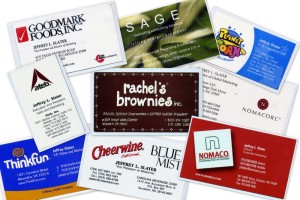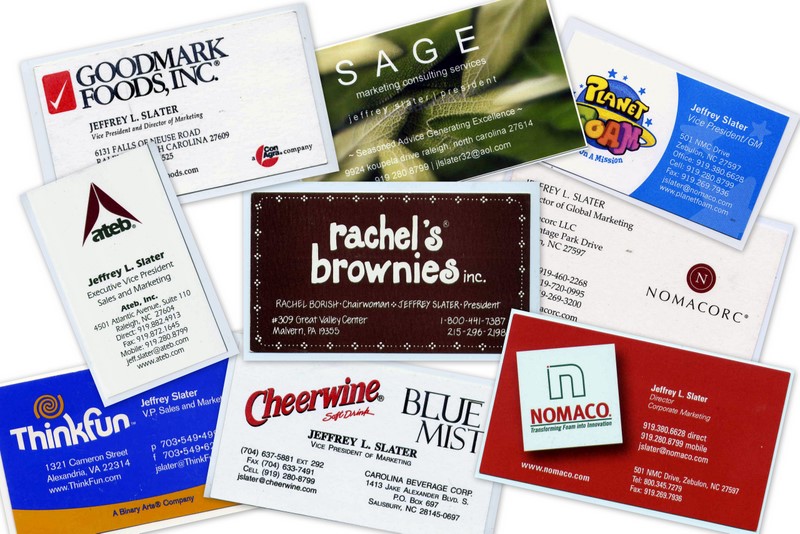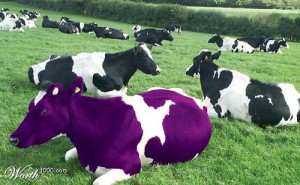 While going through my desk drawer at home, I stumbled upon business cards from most of the jobs I have held over the last 30 years. I worked hard at each of these marketing positions and gained a lot of valuable insights. Most of my marketing experiences have been in consumer packaged goods (CPG) and specifically food and beverage marketing. Although most of my expertise is in B2C marketing (business to consumer), I have also gained a lot of knowledge in the last decade in B2B marketing (business to business).
While going through my desk drawer at home, I stumbled upon business cards from most of the jobs I have held over the last 30 years. I worked hard at each of these marketing positions and gained a lot of valuable insights. Most of my marketing experiences have been in consumer packaged goods (CPG) and specifically food and beverage marketing. Although most of my expertise is in B2C marketing (business to consumer), I have also gained a lot of knowledge in the last decade in B2B marketing (business to business).
My works has been a wonderful fit for me since along with a passion for marketing I have a great hunger for cooking and enjoying fabulous food and wonderful wines. I have been blessed with amazing luck, fortune and grace to be paid to do what I enjoy. In my present position at Nomacorc, I continue to have wonderful creative opportunities, stimulating challenges and many smart colleagues to work with on a range of marketing projects. I would like to share some of the lessons I have learned.
This post is the first in a series of short blog I plan on writing to help illustrate some of these key ideas about the art and science of marketing based on my thirty plus years of expertise.

MY CAREER: With my wife, I owned a wholesale bakery business called Rachel’s Brownies from 1975-1989. After selling the business to GoodMark Foods, I went to work for the Raleigh based firm. From 1989-2004, I held various positions including of VP Marketing for GoodMark Foods who owned a portfolio of brands including Slim Jim’s, David’s Sunflower Seeds, Pemmican and Andy Capp’s along with several others. GoodMark eventually was sold to ConAgra Foods in Omaha.

For one year in 2005, I headed up Sales and Marketing for a telecom technology company called Ateb where I worked on an innovative approach to develop a new network through pharmacy management systems. The following year I helped grow the quirky Cheerwine soft drink brand. Cheerwine is the oldest privately held soft drink company in the US and is primarily distributed in North and South Carolina. In 2006-2009 I worked for Nomaco an engineered foam company whose tagline is “Transforming Foam into Innovation”. (My team created that identity)
In 2009 I started a marketing consulting firm called SAGE (Seasoned Advice Generating Excellence) and for the last several years I hold the position of Global Director of Marketing for Nomacorc, the leader in synthetic closures (corcs) for the still wine industry.
THE THREE C’S
At its core, marketing is about the three C’s –
C o m m u n i c a t i o n s
To work in marketing requires a certain set of creative skills because a large part of the job is figuring out how to get your product or services to stand out from the competition. How can you make your brownie, snack food, soft drink or your wine corc be seen as different and then how do you communicate it to others in a clear and consistent fashion?
What experience has taught me is that you need to see the situation from your target’s perspective- not yours. What space in their brain can you occupy with your product or service? Can you be the all natural product or is that position taken? Can you be the reliable product or does someone already own that territory? What space can you carve out?
I’m fortunate to have worked on brands where I managed very large budgets ($30 million dollars) and very small budgets ($30 dollars). Creativity in marketing isn’t about how much you spend- it is about results you achieve: sales/share/earnings/increased brand awareness.

I remember my Aunt telling me something so counter intuitive about being creative that 40 years later, it still stands out as a magnificent lesson in seeing thing differently. Having worked a little in advertising and copy writing, Annette told me that often the most creative ideas come not from a clean white piece of paper but from putting very specific criteria in place that forces you to see things from a new perspective. The hardest creative challenge is the one that has lots of restrictions, constraints and requirements. Think of music- the creative part isn’t the notes but the silences and pauses in between.
Annette would urge me to challenge myself by trying to take a product- any product- and to describe its unique selling proposition. What makes it special? Write it out for paragraphs and paragraphs until you have it all out of your head and well-defined in a few hundred words. These words should offer you a great chance to describe the products color, taste, texture, size, price and so on.
 |
| Reducing an idea is like reducing a sauce |
The challenge begins once you have explained why your product or service is so special and how it is different from everything else on the market. The creative part is boiling it down- reducing it like a great sauce, to its essence. Can you take paragraphs of copy and say it in a phrase or a few words or better yet- a single word? Can you find a metaphor that succinctly tells the same basic story that your hundred words explains. Making your message simple and clear is the most difficult creative challenge.
I think being creative does require a certain confidence and pleasure at solving these types of problems. Marketing isn’t only about clever copy writing or visual design. It is truly about getting to the essence of a brand and knowing exactly what it represents.
Why is finding the essence of a brand at the core of the creative process?
Without understanding what is essential, it is virtually impossible to communicate it to your target audience. You have to find a way to break through the clutter of messages and incoming information so that the brand can live and breathe its core benefit.
You only have to watch a few car commercials from local dealers to get the opposite of this idea. The dealers want to tell you that they have great deals, lowest prices, special offers and blah blah blah blah blah…
Why listen?
They are all saying the same thing and none of them stand out. They are shouting at you without giving you any reason to want to listen to them. As Seth Godin, a brilliant marketing strategist said in one of his earlier books, you want to be a purple cow standing in a field of brown cows. How are you ever going to be different if you look, sound and smell like everyone else?
An illustration from my experiences may be helpful…
For many years, I was responsible for marketing the Slim Jim brand. For those unaware of this product, a Slim Jim is a dried meat snack, much like a hot dog or smoked sausage, but sold as a shelf stable snack food. This iconic snack food is sold in every 7-11 throughout the USA and has been the butt of late night TV jokes for years. The product was laced with preservatives, salt and many other spicy ingredients that to this day make my inner semi-vegetarian/gourmet self cringe. My job was to profitably grow the brand and increase demand.
A side note: At the time and to this day, I don’t eat red meat so I always thought it odd that I was in charge of marketing a meat snack yet I didn’t eat meat. I wanted my business card to read Vegetarian Vice President of Meat Snack Marketing but my boss didn’t think it was funny. I’m not sure Slim Jim really had anything that qualifies as meat so it may be a moot point.
Through a lot of hard work with many creative partners, we realized what the essence of our products was all about. It wasn’t about the ingredients and it wasn’t really about the taste. There were plenty of competitive products that were twice as big and half the price.
Art Thou Bored? – Slim Jim Commercial
What we uncovered was that the Slim Jim brand was all about was its irreverence. It was the product that Mom didn’t want a teenage boy to eat (our demographic were young male teens). At its most essential: a Slim Jim was the antidote for boredom.
That creative inspiration set in motion all kinds of crazy and bizarre marketing tactics that allowed us to express this idea of being an irreverent brand, that mom didn’t want you to eat. And, if you wanted to break through the monotony of your life, we had the antidote for sale. We then created activities like a music festival called Rebelliache and ads (Snap into a Slim Jim with Macho Man) to communicate to our existing and potential customers.
There were many variations of kids being bored with Slim Jim (the product in the form of Macho Man) as the hero coming to break through the boredom.
Later commercials pushed the limits even further as we knew that if we were to be relevant to teenagers, we needed to be irreverent in our spirit. Every marketing activity had to deliver on the brands essence which to the target audience was positioning the product as an antidote for boredom. In this commercial, the product (AKA Slim Jim Guy) was the antidote for boredom.(when you watch this, remember we were marketing to 13 year teen age boys)
During my tenure on the business we doubled sales and tripled profits on this brand. Under the leadership of Ron Doggett as Chairman and then Dick Miller as President, we were a well-managed company that integrated sales, marketing and operations effectively. Much of the strategic work on our positioning started before I began in my job but continued under my leadership. We successfully nailed the brand’s key emotional hook and our business succeeded by owning a unique position in the minds of our target audience.
The business was so successful that it attracted the interest of a food conglomerate (ConAgra Foods) to acquire the brand along with the rest of the snack portfolio. They paid an extraordinary price because the brand had enormous strength and the business was like an ATM machine- spitting out cash.
ESSENCE OF A BRAND:
- What is the brand essence of your product or service?
- What really drives a consumer or the trade to purchase your product?
- Features aren’t usually connected to emotional buying decisions…but benefits are.
- The strongest benefits tend to have emotional components to them.
- Brands that connect deeply on an emotional basis bring the greatest value and enduring loyalty.
What is the essence of your brand? What problem do you solve for your customers? What solution do you provide to your industry that gives customers something they can’t get from your competitors. Does your brand own one word that your competitors can’t take from you? What is the emotional experience of using your product for your target audience?
When you have simply identified your brand’s benefit to your target, that is the true creative challenge for a marketing professional. Communicating it consistently will be the subject of a future blog post on marketing.
 While going through my desk drawer at home, I stumbled upon business cards from most of the jobs I have held over the last 30 years. I worked hard at each of these marketing positions and gained a lot of valuable insights. Most of my marketing experiences have been in consumer packaged goods (CPG) and specifically food and beverage marketing. Although most of my expertise is in B2C marketing (business to consumer), I have also gained a lot of knowledge in the last decade in B2B marketing (business to business).
While going through my desk drawer at home, I stumbled upon business cards from most of the jobs I have held over the last 30 years. I worked hard at each of these marketing positions and gained a lot of valuable insights. Most of my marketing experiences have been in consumer packaged goods (CPG) and specifically food and beverage marketing. Although most of my expertise is in B2C marketing (business to consumer), I have also gained a lot of knowledge in the last decade in B2B marketing (business to business). 















That IS an incredible journey, Jeff. Thanks for taking the time to journal it and share it with the rest of us.
Great post! I have worked for multiple ad agencies myself, including a several year stint on ConAgra foods. Completely agree with the point about listening to your consumer and also the creative challenge of distilling a brand essence down to one or two words. Too many people want to throw in the “kitchen sink” (thought you’d appreciate the food pun).
Beautiful chronology, Jeff! I love the visual of the business cards – in fact, all the visuals tell your story well. Grace
great story dad, i loved seeing all the business cards too (which i stumbled upon last time i was home and looking for a stamp). that rachel’s brownie one is a real treasure. maybe you should write a book on marketing so somebody could be quoting YOU in their blog…
OMG, I totally had a flashback to eating Rachel’s Brownies – I’m from the Philadelphia Suburbs. Thanks for the sweet memory!